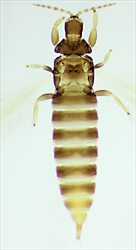
Female macroptera
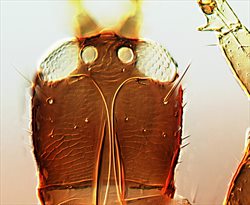
Head of female macroptera
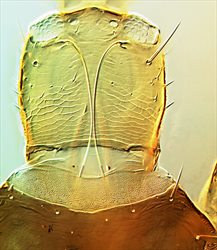
Head of female microptera
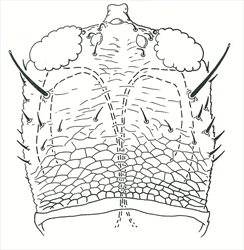
Head of female microptera
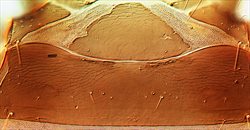
Pelta & tergite II

Male sternite VIII

Female tergites V-X
Both sexes either fully winged or with wings shorter than thorax width. Body and femora of macropterae brown but abdominal segments VIII–X yellowish, tube with terminal grey band; tarsi and most of tibiae yellow; antennal segments III–V weakly bicoloured; micropterae with head, and sometimes pronotum largely yellow. Antennae 8-segmented; segment III with 3 sense cones, IV with 4; VIII constricted to basal neck. Head longer than wide, slightly wider across cheeks than across eyes; cheeks slightly constricted to base, without prominent setae; postocular setae long and pointed, wide apart; maxillary stylets retracted to eyes, close together medially. Pronotum without sculpture medially; with 5 pairs of slender pointed major setae in females; prosternal basantra absent. Fore tarsal tooth well-developed. Metanotum without sculpture medially. Fore wing parallel sided, with about 10 duplicated cilia. Abdominal tergite I, the pelta, with lateral margins confluent with tergite II; tergites II–VII with two pairs of weakly sigmoid wing-retaining setae but these are straight in micropterae; marginal setae S1 long and pointed; tergite IX setae S1 pointed, less than 0.7 as long as tube.
Males varying in size, large males with fore femora swollen and large tarsal tooth; pronotum with stout median longitudinal apodeme, anteromarginal setae not elongate; tergite IX setae S2 short and stout; sternite VIII with narrow transverse pore plate usually interrupted medially, median length of pore plate about 10 microns.
The genus Hoplothrips includes about 120 named species, but there are no modern identification keys to any substantial number of species. The most common species are known to exist as both winged and wingless morphs. Moreover, these species exhibit considerable sexual dimorphism, and males of the same species vary in body size, with some structures exhibiting patterns of allometric growth. As a result, species identification is often difficult (Mound & Walker, 1986; Kobro & Rafoss, 2006; Okajima, 2006). Hoplothrips pedicularius is unusual amongst Hoplothrips species in Britain because of the pale colour of the terminal abdominal segments, and the tube which usually has a distinct grey terminal band.
Breeding on dead branches and sometimes forming colonies on the trunk of dead Angiosperm trees, and often associated with Stereum fungus. Males exhibit competitive behaviour in attracting females (Crespi, 1986).
Widespread and common in Britain from Kent to northern Scotland, and also from Northern Ireland and the Republic of Ireland (Mound et al., 1976), this species is also common throughout Europe and into Russia, and has been reported from Japan (Okajima, 2006).
PHLAEOTHRIPIDAE - PHLAEOTHRIPINAE
Hoplothrips pedicularius (Haliday)
Phloeothrips pedicularius Haliday, 1836: 441
Phloeothrips flavipes Haliday, 1836: 442
Phloeothrips apicalis Reuter, 1880: 25
Phloeothrips brunnea Jordan, 1888: 547
Trichothrips propinquus Bagnall, 1910: 661
Trichothrips britteni Bagnall, 1926: 284
Hoplothrips arnoudi Mantel, 1964: 112
Crespi BJ (1986) Territoriality and fighting in a colonial thrips, Hoplothrips pedicularius, and sexual dimorphism in Thysanoptera. Ecological Entomology 11: 119–130.
Kobro S & Rafoss T (2006) Identification of adult males and females of Hoplothrips species (Thysanoptera: Tubulifera) known from Norway, and some deductions on their life history. Entomologica Fennica 17: 184–192.
Mound LA, Morison GD, Pitkin BR & Palmer JM (1976) Thysanoptera. Handbooks for the Identification of British Insects 1 (11): 1–79.
Mound LA & Walker AK (1986) Tubulifera (Insecta: Thysanoptera). Fauna of New Zealand 10: 1–140.
Okajima S (2006) The Suborder Tubulifera (Thysanoptera). The Insects of Japan 2: 1–720.